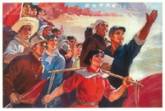

Introduction
|
Questions
|
Internet
Resources
|
The Big Question
|
![]()
![]()
Introduction
|
|
In this
knowledge hunt, you will deepen your understanding about the Cultural
Revolution that took place in China from 1966-1976.
You will learn about certain underlying events, as well as major
people and happenings during the Cultural Revolution years. Your discoveries will provide you with a better awareness
of the events you will be reading about in The Red Scarf Girl. |
Questions
|
|
Who was Mao
Zedong—was he a positive or a negative force for China? What were Mao
Zedong’s goals in beginning the Cultural Revolution? What were some of the
events that led to the start of the Cultural Revolution? The Hundred Flowers
campaign began in 1957—how might it have influenced Mao towards the
Cultural Revolution? Who were the Red
Guards and what did they do? What were the “four
olds”? What role did all the
posters and art play in the Cultural Revolution? According to Mao,
what makes a good Communist party member? What were some of the consequences of the Cultural Revolution—both in the short term and the long term? |
Internet Resources
|
|
Mao
Zedong - Wikipedia, the free encyclopedia Read this brief biography of
Mao Zedong. Consider the fact
that your perspective may vary from that of someone who lived in China. Hundred
Flowers Campaign - Wikipedia, the free encyclopedia Read about the
Hundred Flowers campaign. At
least it sounded nice… MSN
Encarta - Cultural Revolution: Good overview, will help with
understanding underlying events. Cultural
Revolution Art & Poetry: Mao, Cultural Revolutionary, poetry, posters Poetry
by Mao as well as posters from the Cultural Revolution. Visual
Art as Cultural Memory in Modern China Posters. Government
and Politics: What Makes a Good Communist Party Member? Mao and other
party leaders examine this question. |
The BIG Question
|
|
Consider Mao’s
initial goals for the Cultural Revolution.
Were these goals met? Explain whether you believe Mao was a
successful or unsuccessful leader, especially in light of the Cultural
Revolution. |
|
|
|
Note: Graphic poster
above from: |
|
|
|
|